Editor's note: This is a transcript of the live seminar presented on August 25, 2011. To view the course recording, register here.
This course is part of a series of talks that I am giving on AudiologyOnline this year entitled Signal Processing in Real Life. What I have been trying to achieve in these courses is to look at some of the major signal processing techniques and other aspects of hearing aid fittings from a technical standpoint and discuss how they actually work in everyday situations. The other courses in this series are:
Dynamics: The Third Dimension of Speech
Situational Performance of Noise Reduction & Directionality
Cognitive-Based Assessment of Signal Processing
Today's topic is open fittings. Open fittings are not anywhere near as mysterious as they were over five years ago when they started becoming more widespread, but I still believe there are a few issues about open fittings that deserve discussion.
Feedback Cancellation: A Precursor to Open Fittings
Open fittings became possible with the development and implementation of true feedback cancellation. Today, nearly every hearing aid has some version of feedback cancellation. Those of you who are new to the field may not remember when this technology was not available. The advancement of phase-cancellation feedback management allows us to fit the moderate high-frequency hearing loss with relatively wide venting. Before, this was a dicey proposition because of the occurrence of feedback. With very effective feedback management from hearing aid companies today, being able to fit a patient with more open venting has become a reality. It has great benefits for patients, but probably in more subtle ways than many audiologists recognize. Let's examine feedback cancellation in more detail, beginning with the engineering that is behind these complex algorithms.
Feedback is a concrete and complex signal, and to be able to identify and cancel it in a very short time period is very impressive. The bottom panel of Figure 1 shows an in-ear frequency response of a hearing aid without feedback; in the top panel, you see the response of the same hearing aid, but this time with feedback induced by holding my hand close to the microphone.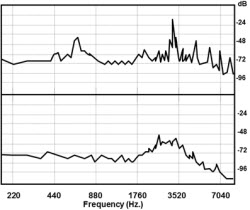
Figure 1. Frequency response of a hearing aid with feedback (top panel) and without feedback (bottom panel).
We generally consider feedback as tonal, meaning that there is some high-frequency tone that exists in the hearing aid response. In reality, feedback in hearing aids is much more complex. There is usually one dominant tonal signal in the response of the hearing aid, but there are also many other peaks that occur in the response. When feedback does occur in a hearing aid, it is usually a relatively complex waveform. Therefore, a nearly instantaneous feedback solution created by a hearing aid to suppress the feedback loop also has to be pretty complex. It does not just find one tonal component, but actually has to account for several different tonal components. I am sure anyone who has worked with or worn hearing aids has heard different-sounding feedback. You can create different sounds of feedback simply by changing the reflection of the sound waves near the hearing aid that generates the feedback. Each of those response patterns is going to require a different solution in the feedback cancellation techniques employed by the hearing aid.
It is important to remember that feedback strategies have evolved over time. Engineers who develop the feedback algorithms deserve a lot of credit. Before feedback cancellation existed there were different options that were used in lieu of a digital algorithm. Turning down the volume of the hearing aid was a typical approach. Sometime during the 1980s it became commonplace to have a high-frequency tone control to roll off the high frequencies. It was intended to be used to adjust the tonal balance of the hearing aid, but in actuality, those high-frequency tone controls were used to cut out the high frequencies to avoid feedback. When multiple-channel filtering was developed in the early digital era, before feedback cancellation became widespread, narrow high-frequency channels were used to notch the response of the hearing aid to try to decrease the tendency for the hearing aid to feed back. You would find an area in the frequency response, typically around 3000Hz, and you would put a small notch in the hearing aid settings for feedback. However, placing a notch at one frequency region is not going to be a long-term solution.
When the hearing aid employs phase cancellation, it is looking for high-frequency tonal or narrowband characteristics that are above what would be expected of the normal hearing aid's response to input. The hearing aid analyzes the waveform specifically. It essentially copies the waveform and creates a response 180 degrees out of phase and adds that back in to the system output, cancelling out the feedback wave. This is obviously a simplistic description of a far more complex process that actually occurs.
For example, there might be some very short term notching of the response to immediately get rid of the feedback while the system is creating the solution in a matter of moments. In some of the systems in the marketplace, there is some frequency shifting that occurs. It finds the tonal component and then shifts the feedback loop and that frequency. The shift may be permanent in the hearing aid or it may be just temporary while it tries to find an improved solution that better preserves sound quality. That is one of the techniques used in the more advanced systems. There are many engineering techniques that are used to both ensure sound quality and the very rapid solution to the feedback problem that goes beyond simple phase cancellation.
If you view how a hearing aid handles feedback in real time on a spectrograph, it's very interesting. A spectrograph arranges frequency along the y-axis, from low frequency to high frequency, and time runs along the x-axis. If you turn on a hearing aid, induce feedback and watch the spectrograph, you'll notice a definite feedback component, with a harmonic series above that primary component. The hearing aid then immediately goes in to a mode where it is trying to solve that feedback component. It comes up with a temporary solution after about a quarter of a second that changes the feedback just slightly, and then after about half a second, the feedback is gone. So in only about 500 milliseconds, the hearing aid identified that feedback was occurring, came up with a temporary solution, then a final solution that eliminated the feedback. That is a pretty impressive amount of signal processing that is accomplished in less than a second's time. Today, there are a lot of demands on hearing aid designers and engineers to make a system that never allows the patient to hear feedback whatsoever. When you consider all of the signal processing taking place within those first few moments after a hearing aid turns on, I think we have to not lose sight of how elaborate some of these feedback cancellation processes really are.
It is the clinician's responsibility to understand the feedback system as well as potentially what gets sacrificed with the system. For example, in the past we knew that turning down the volume control in response to feedback sacrificed too much of the frequency response and audibility, so we needed to have a better solution. The better solution that came along in the 1980s involved rolling off the high frequencies, which also impacted clarity and speech intelligibility. Narrow band-notching sacrificed less of the frequency response. Now we are to the point where the feedback cancellation systems are programmed very well so that we do not sacrifice anything in terms of the frequency response of the hearing aid, which is what we wanted to achieve all along.
Some of the engineering techniques used to make feedback cancellation occur very rapidly in hearing aids, however, may sacrifice some sound quality. The compression strategies and very fast manipulation of the frequency response that is being fed back into the output of the hearing aid can change, briefly, how the hearing aid would normally sound in a calm listening environment. With some of the frequency shifting or notching that might be happening, you may experience a change in the sound quality. Like all good things in this world, nothing comes for free. When a hearing aid designer sits down to develop a feedback cancellation algorithm, they have to decide how much of a cost, or risk, they are willing to take.
That cost can come in many different ways in a hearing aid. It can come in processing power. If you put all the advanced signal processing systems to work in the hearing aid at once- such as the feedback cancellation system, noise reduction, directionality and binaural processing- you limit the processing resources available and something will be sacrificed.
The hearing aid designer also has to decide how much of a sound quality issue they are willing to accept. When a hearing aid has a very aggressive, fast-acting feedback cancellation approach, there is going to be a sound quality cost somewhere. Trying to minimize that sound quality cost and still have the desired feedback cancellation effect becomes a real signal-processing challenge. This is not immediately apparent to the professionals who fit hearing aids. There are significant differences and tradeoffs from one manufacturer to the next; everyone's feedback algorithm is going to be implemented a little differently, some more dramatic than others. However, they are all made with some sort of cost-benefit calculation. Most audiologists will evaluate the effectiveness of a feedback algorithm in terms of whether the hearing aid feeds back or not, which, of course, is the bottom line for the patient as well.
Here is a good way to show how feedback cancellation actually preserves the frequency response to the hearing aid. I did an experiment where I put a hearing aid on KEMAR and then introduced white noise into the hearing aid (Figure 2, left panel). I let it run for a little bit and what you see in Figure 2 is the frequency response to the hearing aid before the feedback occurred. It is set up to be a broadband hearing aid. I then held up my hand to KEMAR's ear to induce feedback, which you see is evident as a spike in the waveform at about 2700 Hz (Figure 2, middle panel). 2700 Hz is actually the canal resonance of KEMAR so it is not surprising that is where the feedback would occur. I let the feedback algorithm kick in, which took less than a second to eliminate the feedback. When you take a look at the frequency response with the feedback algorithm active (Figure 2, right panel), you see that the spike around 2700 Hz is gone. Whatever solution was used to make that spike go away did not make a change to the overall frequency response, meaning that the algorithm provided true feedback cancellation, not a shift or alteration of the response. The feedback was canceled on an on going basis because this entire recording was taken with my hand still in place, which would have perpetuated the feedback. Not all feedback cancellations are ongoing as the one in this example.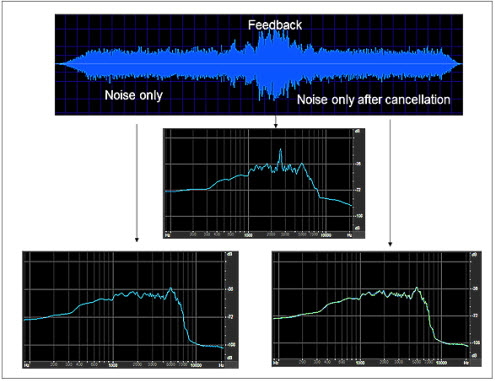
Figure 2. Example of a broadband noise input to a hearing aid (left panel) and that same input with a feedback loop initiated (middle top panel). Feedback cancellation is applied, maintaining the original input of the original noise source (right panel).
Oticon uses a dual-approach feedback system, and we are not the only manufacturer who uses this type. We have both a fast-response and a slow-response feedback system, which are relative terms, because in both cases the feedback solutions occur within milliseconds. The fast-response system is designed to work within a few milliseconds. To solve the feedback problem in less than a second might result in a notch in the response of the hearing aid to make the feedback go away immediately so the patient does not hear it while a long term solution is activated and held constant. So what we have is a combination of a very rapid response system to make the whistling go away immediately, and then a long-term solution that is better for sound quality and better preserves the frequency response to the hearing aid. Different combinations of very rapid, aggressive approaches versus less rapid, less aggressive approaches are used to try to develop these feedback solutions in the hearing aid. It becomes a much more complicated area than you might realize.
The Move To Open Fittings
Because we now have feedback solutions that work, it allows us to fit hearing aids in a more open manner. In general, most people believe that the primary importance of the open fit is to eliminate the occlusion effect, and that is absolutely true. Before open fitting, manufacturers were trying to figure out how to create custom products with larger venting and no feedback. Custom products were the cosmetic hearing aid of choice, but patients wanted them to feel more transparent without the "head in the barrel" feeling. The movement towards mini BTEs (behind the ear) using thin tubes or RITE (receiver in the ear) hearing aids has progressed to the point where we can now have very open, non-occluding fittings. We believe the benefits of this kind of fitting go far beyond a physical feeling of being open. As a reminder, the more open the fitting, the more low frequencies escape the ear canal, including the patient's own voice, which is the bulk of the occlusion effect.
Not all patients exhibit the occlusion effect when the ear canals are closed off. Some may have unvented earmolds who show an enhancement of less than 10 dB of their own voice in the low frequencies, whereas other patients with open venting are still exhibiting some level of their own voice in their ear canal. An open fitting is not a guaranteed solution for all patients who are reporting occlusion. Additionally, vent size might have a more dramatic effect on some patients than others. The natural variation from patient to patient is an important factor to consider. As you know, the larger you make the vent, the more low frequencies you roll off, to the point where you can provide no gain at those frequencies. This is referred to as tube venting or open venting such as using thin tubes with domes. These configurations can have a very dramatic effect on the frequency response below 1000 Hz. It becomes even more of an audiological issue when you move to the very open fittings as you are going to see an effect on the response up to 2000 Hz. How much of an impact this is going to have audiologically on the fitting is an important consideration.
Figure 3 is data that we collected on vent size and the effect it has on patient's own voice for two different vowels: /i/ and /u/. The study was done with an older custom Oticon product. What we observed is that vent size does have an effect on the patient's perception of occlusion. When you go to the large vent sizes of 4 millimeters and beyond, you can be pretty sure that you have eliminated most negative occlusion effects that the patient might experience.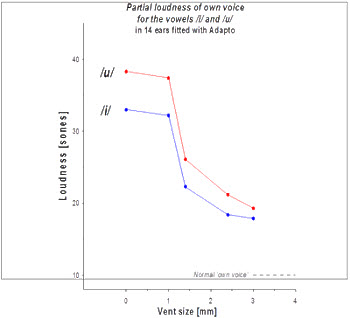
Figure 3. Effect of vent size on loudness perception for the vowels /u/ and /i/.
Venting is gradually becoming a lost art. Custom products have seen a steady decline over the past ten years in the industry, in part because of venting difficulties and occlusion. However, we are seeing a resurgence in the marketplace of very small, deeply-seated canal hearing instruments, so custom products are definitely not on the way out. Even so, the laws of physics still apply. The principles of what creates occlusion and the mechanisms to diminish it still exist. As you know, the maximum effective venting for open ear products is typically extremely large because of the domes on the receiver or thin tubes. By having essentially no blockage in the ear canal, these become much more effective in terms of how much of the low frequencies can bleed out.
One of the new trends we are seeing are called hollow molds. Some patients cannot wear the standard domes because of retention issues or maybe extra feedback issues, so patients can instead be fit with custom molds that have a hard shell exterior and are hollowed out on the inside. The idea here is that if you put a small diameter vent, 1 to 2 millimeters, down at the ear canal end, you get a very effective venting technique because there is absolutely no mass to the mold that the sound has to fight through. It immediately goes into a very open hollow space. The effective venting we can create with these newer generation hollow molds is much better than we have seen in the past.
Effect of Direct Sound
One of the things to remember is that hearing aids take time to process sound. It is a referred to as digital delay. Figure 4 is a sound sample that I created of a woman talking (top panel), and then I delayed it by 50 milliseconds and added it back in (bottom panel). The delayed signal is amplified by about 15 dB. The idea here was an attempt to replicate what would happen if you fit an open fit hearing aid with a very long delay. What you see is an offset at 50 milliseconds between the original sound entering the ear canal and the delayed sound. This creates an audible echo, which can be disturbing to the patient.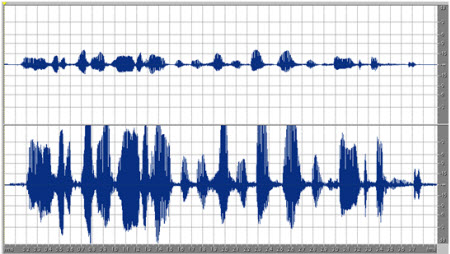
Figure 4. Example of manufactured digital delay, the top panel showing the original sound recording, and the bottom panel showing an amplified version of the same passage and set at a 50ms delay. When the natural sound enters the ear followed by an amplified version of the same input by the hearing aid, the patient can experience an echo.
Data from Stone & Moore (2003) examined the effect on word recognition for different delays in the digital delay path and in terms of the disturbance rating of the hearing aid. They found that a delay of even 25 milliseconds is going to have an effect on both how bothered the patient is about the sound and also on the patient's performance of the listening task. If you can keep the delay down to about 5 milliseconds you are doing well. The disturbance rating is not that much higher at 5 milliseconds as compared to no delay, and the word recognition score is still relatively high. Five milliseconds seems to be the standard that is used in our industry. That was not always the case. When digital hearing aids first came out, those delays would have been a lot longer, even close to 50 milliseconds in some cases.
One effect most people recognize with open fittings is a loss of low-frequency energy. You have to account for that low-frequency roll off in the fitting. The other effect of open fittings is that you have direct sound entering the ear canal. We talked about the negative side effects of direct sound entering the ear canal in terms of a delay and echo, but there are also some positive aspects of direct sound entering the ear canal. That is probably the one aspect of open fittings that I think is underappreciated by audiologists, what the hearing aid is doing in combination with the direct sound entering the ear canal.
Normally we think of a hearing aid fitting as if the hearing aid does all the work. Today it does not work that way. With an open fitting, the patient hears both what the hearing aid is doing and what is entering the ear canal directly. The vent effect on direct sound is not much in the low frequencies. In other words, open venting allows low frequency sound to directly enter the ear canal without being attenuated, but it does roll off the high frequencies significantly.
It is important to remember that the direct sound can have an effect on performance, especially in terms of localization. Even with a thin tube fitting you can have some roll off in the high frequencies from direct sound above 2000 Hz or so. What you also have to remember is that low-frequency sounds are going to enter the ear canal without being rolled off whatsoever. That is something that the patient is also listening to when they are wearing an open-fit hearing aid. In terms of the effect of high-frequency roll off on localization, error scores are highest with the most closed fittings (Byrne, Sinclair & Noble, 1998). The patient is less prone to errors on localization tasks as you open up the fitting because you are allowing more direct high-frequency sound to come in the hearing aid. If you see the error scores drop as you increase the venting, that means that the patient must be using more of the natural sound entering the ear canal rather than just the processing of the hearing aid with the localization task.
There are other positive effects to having fittings as open as possible. A soft custom mold that is made for a receiver-in-the-ear product with a very short, large vent, about 4 millimeters, should be ample to allow the high frequencies in the ear canal. However, there will be a significant roll off in the high frequencies, even with a vent that large. We do see, however, that the domes which are fit on the RITE or slim tube products do a good job of not affecting the high-frequency response whatsoever.
Figure 5 depicts the differences in the real-ear response of the open ear, open dome, and a custom mold with a large vent. The open-ear response appears dark red, and the lighter red directly below is the response of the open dome. I believe that there is an advantage in these fittings of two sound sources. When the patient listens, they are hearing the amplified signal from the hearing aid. Plus they are hearing the addition of natural sounds beyond the bandwidth of the hearing aid. The sum of those signals together improves the overall listening experience. As long as the digital delay is short, you are not going to get that echo effect.
Figure 5. Real-ear response of the open ear (dark red line), an open dome on a thin tube (light line directly beneath dark red line), and that of a custom earmold with a large vent (light line distinctly below the other two lines), demonstrating that the custom earmold with the large vent has the least amount of high-frequency emphasis.
Patients like fact that their ear canal is not closed off and that they are not hearing their own voice. They benefit from a much broader sound quality than they would have with the same hearing aid fit to a closed earmold.
Verification of an Open Fitting
When we fit an open hearing aid and we know that the frequency response is going to roll off in low frequencies and perhaps to some degree in the mid frequencies. The question then becomes, what do we want the target fitting to be? Do you want to try to match NAL targets, for example? Different manufacturers are going to approach this problem in different ways. We assume that when we fit an open hearing aid, we will get a combination of sound sources in the patient's ear canal. With direct sound coming in the ear canal in the low frequencies and into the mid frequencies, it is not necessary to correct the frequency response of the hearing aid to make up for what is being bled out of the open vent. Candidates for open fittings typically will have good hearing in the low and mid frequencies, so the idea of having to amplify sound in that region is not as important.
Figure 6 depicts the way we approach an NAL fitting in a closed condition versus an open condition for an audiogram with a moderate sloping high-frequency hearing loss and normal hearing in the very low frequencies. You can see there is no NAL gain called for at 500 Hz. The right panel is the way you would fit that patient if you told the Oticon Genie fitting software you were doing an open fit. It looks as if the patient is not hearing anything, but we can assume that the patient is getting direct natural sound in the low-to-mid frequency region so we are less aggressive about trying to fit the NAL targets in those regions. It is only in the high frequencies where we try to replicate the NAL targets. We do roll off the high frequencies a little bit for sound quality reasons to try to keep the listeners from being overwhelmed by the sharpness of the response.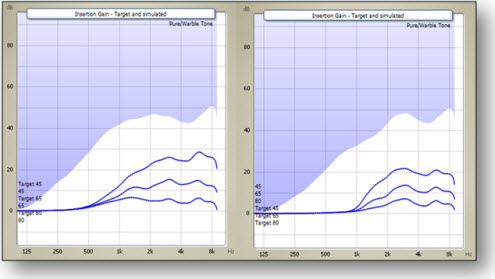
Figure 6. Insertion gain of a closed fitting (left panel) versus an open fitting (right panel) based on NAL-NL2 targets.
It is also important to consider the total loudness that the patient experiences as it will be different in the occluded condition versus the open condition. In the open condition we expect that they are getting that broader frequency response with the low frequencies included. That adds to the total loudness perception and you do not have to compensate quite as much for the loudness in the high frequencies. So, in our opinion, prescriptive target fittings do change a little bit in an open fitting; keep in mind that you are not compensating for the low frequencies through amplification.
Not Just Cosmetic?
One more point that I want to make before we wrap up is concerning the output differences between a RITE hearing aid compared to a thin-tube hearing aid (with the receiver in the aid). This is sometimes referred to as a RITA (receiver in the aid). RITE hearing aids place the receiver down close to the eardrum, so the acoustic signal does not travel down a hollow tube before it reaches the ear drum. You see both approaches in the marketplace these days, but I would venture to say the RITE approach is becoming more common than the thin tube approach. The fittings of these different hearing aids are slightly different because the thin tube creates a frequency response with more peaks and valleys; the RITE response is smoother (Figure 7).
Figure 7. Response of thin-tube hearing aid with receiver in the aid (grey line) and a RITE hearing aid (purple line). Notice the smoother response of the RITE hearing aid.
One of the things that modern hearing aids allow is a very precise shaping of the frequency response. If you fit a hearing aid with a thin tube, you may compensate for the peaks and valleys. There is a little cost in the compensation, however. Figure 9 shows a comparison between an Oticon Syncro Corda thin tube and an Epoq RITE. What I attempted to do was shape the insertion gain in KEMAR's ear so the two outputs were similar. Visually, you can see that the responses are similar. The response from the thin tube rolls off earlier in the high frequencies, but that is because of the narrow band pass filtering of that particular hearing aid. I had a little more trouble getting the fit up to targets in the mid frequencies. The mid to high frequencies, where we tend to be very focused on the frequency response, are a pretty good fit. However, I did have to manipulate some things in the 2-cc coupler to get that matching.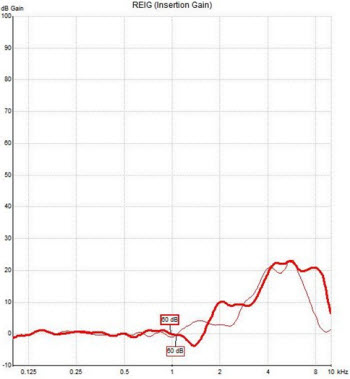
Figure 8. Attempted response-matching for an Epoq RITE (dark red line) and a Syncro Corda thin-tube fitting (thin pink line).
The dark line (Figure 8) is the response in the 2-cc coupler for the RITE hearing aid. The lighter color line is what I had to do with the thin tube response to get the same insertion gain. I had to add additional gain in the mid frequencies to make up and compensate for some of the spikiness. That left less flexibility in the adjustment of the hearing aid later. The software, by default, is going to put blocks on how much you can increase the gain in the different bands in the hearing aid, especially in the high frequencies, and because I had to use so much of the headroom to make up for the irregularity of the response I will not be able to add much more gain in the future if the patient needs it. Additionally, I may have created feedback issues, and now I do not have as much flexibility in the high frequencies. In general, we believe there is a place in the marketplace for thin-tube responses along with RITE responses, but because of this flexibility issue, we tend to recommend RITE responses more often because you preserve more flexibility for fine-tuning adjustments. There are reasonable situations where a thin-tube is seen as more appropriate, such as in cases of excessive wax or drainage problems. But if all else is equal, we tend to recommend placing the receiver in the ear canal because, acoustically, it creates a smoother response. It is a subtle point, but an important one; these two acoustic systems are not equivalent to each other.
Although this was likely review for many of you, I hope this was able to provide some insight into open fittings. The next course in the Signal Processing in Real Life series, "Cognitive-Based Assessment of Signal Processing" took place on November 16, 2011. View the recording here.
Question & Answer
In an open fitting, is there any way to measure the actual frequency response in a patient's ear canal that accounts for both direct sound as well as the amplified signal?
The way you can do that is with an aided response measurement. In other words, if you just measure insertion gain, you are not going to see the full amplification. This is because insertion gain is only what the hearing aid adds in; it does not account for whatever sound is coming in the ear canal. However, if you do an aided response on an SPLogram you may see the effects of both the hearing aid as well as the natural sound.
Can you address directionality in open fittings?
That was one of the slides I did not get to. Directionality is still effective in open fittings, but it is effective in the mid to high frequencies. In other words, by rolling off the response in the low frequencies of the hearing aid, whatever directional effect you had below around 1500 Hz gets somewhat lost. However, you still get a full response out of the hearing aid in the mid to high frequencies for open fittings, and that is typically where most directional systems are fine tuned to provide the most directionality. It is an older myth that open fittings destroy directionality.
References
Byrne, D., Sinclair, S., & Noble, W. (1998). Open earmold fittings for improving aided auditory localization for sensorineural hearing losses with good high-frequency hearing. Ear & Hearing,19, 62-71.
Stone, M.A., & Moore, B.C.J. (2003). Tolerable hearing aid delays. III. Effects on speech production and perception of across-frequency variation in delay. Ear & Hearing, 24(2), 175-183.
A Broader View of Open Fittings
January 30, 2012
Share:
This article is sponsored by Oticon.
Related Courses
1
https://www.audiologyonline.com/audiology-ceus/course/deeper-look-at-sound-environments-33536
A Deeper Look at Sound Environments
The characteristics of the sound environment have a fundamental impact on the performance of the hearing aid user. In this course, we will describe the obvious and sometimes more subtle aspects of sound environments that will affect hearing aid performance.
auditory, textual, visual
A Deeper Look at Sound Environments
Presented by Don Schum, PhD
Course: #33536Level: Intermediate1 Hour
AAA/0.1 Intermediate; ACAud/1.0; AHIP/1.0; ASHA/0.1 Intermediate, Professional; BAA/1.0; CAA/1.0; Calif SLPAB/1.0; IACET/0.1; IHS/1.0; Kansas, LTS-S0035/1.0; SAC/1.0
The characteristics of the sound environment have a fundamental impact on the performance of the hearing aid user. In this course, we will describe the obvious and sometimes more subtle aspects of sound environments that will affect hearing aid performance.
2
https://www.audiologyonline.com/audiology-ceus/course/subjective-evaluation-new-hearing-aid-35584
The Subjective Evaluation of a New Hearing Aid Fitting
The final judge of the success of a new fitting will of course be the patient, and the criteria that they use may not always be in line with an objective audiological measure. This course will review some of the issues and options at play when having the patient weigh in on the value of the new devices.
auditory, textual, visual
The Subjective Evaluation of a New Hearing Aid Fitting
Presented by Don Schum, PhD
Course: #35584Level: Intermediate1 Hour
AAA/0.1 Intermediate; ACAud/1.0; AHIP/1.0; ASHA/0.1 Intermediate, Professional; BAA/1.0; CAA/1.0; Calif SLPAB/1.0; IACET/0.1; IHS/1.0; NZAS/1.0; SAC/1.0
The final judge of the success of a new fitting will of course be the patient, and the criteria that they use may not always be in line with an objective audiological measure. This course will review some of the issues and options at play when having the patient weigh in on the value of the new devices.
3
https://www.audiologyonline.com/audiology-ceus/course/oticon-government-services-may-2023-38919
Oticon Government Services May 2023 Contract Update
Oticon understands that sudden, disruptive sounds affect a large majority of hearing aid users, making it difficult to stay sharp and focused – especially when engaged in conversation. Oticon Real™ is designed to help with this challenge and keep patients engaged. In this course we introduce new options on the VA hearing aid contact.
auditory, textual, visual
Oticon Government Services May 2023 Contract Update
Presented by Kirstie Taylor, AuD
Course: #38919Level: Intermediate1 Hour
AAA/0.1 Intermediate; ACAud/1.0; ASHA/0.1 Intermediate, Professional; BAA/1.0; CAA/1.0; IACET/0.1; IHS/1.0; Kansas, LTS-S0035/1.0; NZAS/1.0; SAC/1.0
Oticon understands that sudden, disruptive sounds affect a large majority of hearing aid users, making it difficult to stay sharp and focused – especially when engaged in conversation. Oticon Real™ is designed to help with this challenge and keep patients engaged. In this course we introduce new options on the VA hearing aid contact.
4
https://www.audiologyonline.com/audiology-ceus/course/oticon-cros-revolutionary-sound-experience-35592
Oticon CROS: A Revolutionary Sound Experience
This course will review the Oticon CROS family, which sets a new standard among CROS/BICROS hearing aids. Our revolutionary TwinLink dual-streaming technology offers exceptional sound quality for an immersive listening experience for those with single-sided deafness allowing users to take advantage of today’s technology without compromise.
auditory, textual, visual
Oticon CROS: A Revolutionary Sound Experience
Presented by Rob Dowling, AuD, FAAA
Course: #35592Level: Introductory1 Hour
AAA/0.1 Introductory; ACAud/1.0; AHIP/1.0; ASHA/0.1 Introductory, Professional; BAA/1.0; CAA/1.0; IACET/0.1; IHS/1.0; Kansas, LTS-S0035/1.0; NZAS/1.0; SAC/1.0
This course will review the Oticon CROS family, which sets a new standard among CROS/BICROS hearing aids. Our revolutionary TwinLink dual-streaming technology offers exceptional sound quality for an immersive listening experience for those with single-sided deafness allowing users to take advantage of today’s technology without compromise.
5
https://www.audiologyonline.com/audiology-ceus/course/more-power-choice-freedom-33546
More Power. More Choice. More Freedom
Oticon Opn S built on the OpenSound paradigm delivering improved speech understanding while reducing listening effort. Now with Oticon Xceed, we extend the open sound experience to patients with severe to profound hearing impairment. For individuals struggling with single sided deafness, we bring the benefits of open sound experience with a new CROS solution.
auditory, textual, visual
More Power. More Choice. More Freedom
Presented by Kelly A. Stahl, AuD
Course: #33546Level: Intermediate1 Hour
AAA/0.1 Intermediate; ACAud/1.0; AHIP/1.0; ASHA/0.1 Intermediate, Professional; BAA/1.0; CAA/1.0; IACET/0.1; IHS/1.0; Kansas, LTS-S0035/1.0; NZAS/1.0; SAC/1.0
Oticon Opn S built on the OpenSound paradigm delivering improved speech understanding while reducing listening effort. Now with Oticon Xceed, we extend the open sound experience to patients with severe to profound hearing impairment. For individuals struggling with single sided deafness, we bring the benefits of open sound experience with a new CROS solution.


